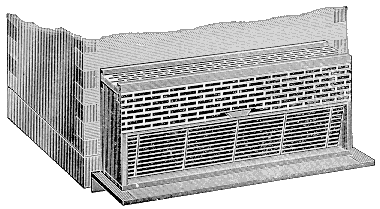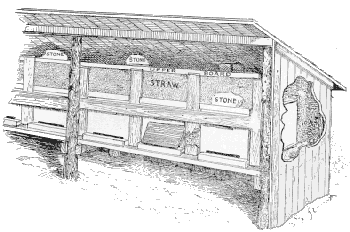John's Beekeeping Notebook
A Taste of
American Beekeeping History
Bees
Bee Hunting
Glass-topped boxes were used to find wild bee colonies. The wild colonies would be raided for the honey, and the bees sometimes put into a bee hive.
Bees were tempted into the box with a sweet syrup or honey, and the hunter followed the bees as they flew back to their colony. A.I. Root described how to use the hunting box:
"The only season in which we can trap bees is when they will rob briskly at home... Cautiously set the box over the first bee you find upon the flowers. As soon as the box is well over the flower, close the bottom with your hand, and the bee will buzz up against the glass. Catch as many as you wish, in the same way, and they will soon be sipping the honey. Before any have filled themselves, ready to fly, place your box on some elevated point, such as the top of a stump in an open space in the field, and draw back the glass slide....
"When a bee comes back, you will recognize it by the peculiar inquiring hum, like robbers in front of a hive where they have once had a taste of the spoils.... As soon as you are pretty well satisfied in which direction they are located, you can close the glass slide and move along the line, nearer the woods. Open the box and you will have them just as busy again; mark the line and move again, and you will soon follow them to their home. To aid you in deciding where they are, you can move off to one side and start a cross-line. Of course, the tree will be found just where these lines meet."
Swarms
Until the late 1800's, catching swarms was a primary way of increasing one's colonies. Several devices were designed to help stop or catch swarms as they left the hive.

The basic concept in most of these devices was to direct a swarm into another hive or enclosed area. There also devices designed to stop queens from leaving the hive.


Queen RearingGrafting of worker larva to raise queens began in the late 1800's. Before that, some books described how to cut worker comb containing eggs and place it in a queenless hive.
Shipping bees through the postal system has not changed much during the past 100 years. In the 1890's, Italian and Carniolan queens cost about $1 each. The black bee that had been popular in earlier years cost about 25 cents. Hybrids cost about 40 cents. Albino queens were also available. I did not see any mention of the Caucasian bee in U.S. beekeeping books from the 1800's.
Bee Diseases & Parasites
Foulbrood was the most feared bee disease.
The wax moth was accused of destroying healthy bee colonies. Today we know that the wax moth is almost always controllable by a healthy bee colony, and that its presence in a hive is usually a symptom of another problem. One creative beekeeper's way of controlling wax moth follows below, quoted from a book titled "Moore's Universal Assistant" (1878):
"HENS MADE TO PROTECT BEES. - A bee raiser has patented an invention for the protection of bees from the attacks of the honey bee moth, which enters the hives at night, and rifles the stores.... Hens, he observed, retire to rest early; but bees seek repose earlier still; no sooner are they sunk into slumber, than the moths steals into their abode and devours the produce of their toil. He has now built a stand of hives with a hen house connected. The bees first betake themselves to their dwelling and settle themselves for the night. The hens then come home to roost on their perch, and as they take their places upon it, their weight sets some simple mechanism to work, which at once shuts down the doors of all the hives. When the day dawns, however, the hens leave their roost, and the removal of their weight from the perch raises the hive doors, and gives egress to the bees in time for their morning's work."
Oil pots with flaming wicks were also used to attract and kill moths.
Wintering
Wintering hives in field shelters or cellars seemed popular in the northern U.S. One magazine article suggested 40-45 degrees f to be the ideal temperature for wintering bees in a cellar.


